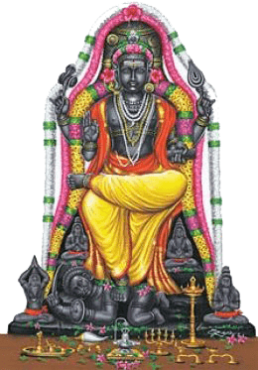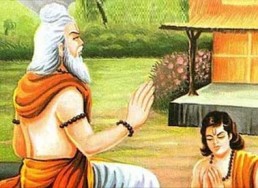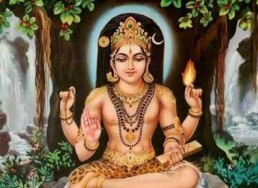Sada Shiva Samarambam
अस्मदाचार्य पर्यन्तां वन्दे गुरु परम्पराम्॥
asmadācārya paryantāṃ vande guru paramparām..

Description
The Advaita Guru-Paramparā (“Lineage of Gurus in Non-dualism”) is the traditional list (parampara) of divine, Vedic and historical teachers of Advaita Vedanta. It begins with the Daiva-paramparā, the gods; followed by the Ṛṣi-paramparā, the Vedic seers; and then the Mānava-paramparā, with the historical teachers Gaudapada and Shankaracharya, and four of Shankara’s pupils. Of the five contemporary acharyas, the heads of the five Advaita mathas, four acharyas trace their lineage to those four pupils and one to Adi Shankara himself.
Deva, Rsi and Manav Paramparā
The Advaita guru-paramparā (Lineage of Gurus in Non-dualism) begins with the mythological time of the Daiva-paramparā, followed by the vedic seers of the Ṛṣi-paramparā, and the Mānava-paramparā of historical times and personalities:
Daiva-paramparā
Nārāyaṇa
Padmabhuva (Brahmā)
Ṛṣi-paramparā
Vaśiṣṭha
Śakti
Parāśara
Vyāsa
Śuka
Mānava-paramparā
Gauḍapāda
Govinda bhagavatpāda
Śankara bhagavatpāda, and then Shankara’s four disciples
Padmapāda
Hastāmalaka
Toṭaka
Vārtikakāra (Sureśvara) and others
Each Yuga has its own gurus or Acharyas:
In the Satya or Krata Yuga: Lord Narayana and Lord Brahma.
In the Treta Yuga: Vasishta Maharishi, Śakti Maharṣi and Parashara Maharishi.
In the Dvapara Yuga: Veda Vyasa and Sri Shuka Acharya
In the Kali Yuga: Sri Gaudapada Acharya, Govinda Bhagavatpadacharya, Shri Shankarāchārya, and the subsequent lineage.
Jagadgurus of the four Advaita Mathas
According to tradition, Sankara organised a section of the Ēkadaṇḍisannyāsins into the Dashanami Sampradaya, establishing four mathas in north, west, east, and south India, to facilitate the teaching of Advaita Vedanta, and maintain the dharma. He entrusted his four disciples to each of these four mathas. Some of the famous and current Mathadhipatis titled ‘Sankaracharyas’ are listed below:
Sringeri Sharada Peetham
Sri Sacchidananda Shivabhinava Narasimha Bharathi Mahaswami, Jagadguru of Sringeri Sharada Peetham (1865–1912); initiated many into Adi Shankaracharya’s philosophy including Sacchidanandendra Saraswati- founder of Adhyatma Prakashana Karyalaya; known as “Abhinava Shankara” because of his many tours around Bharatvarsha spreading the Advaita Vedanta philosophy and Hindu Dharma
Sri Chandrashekhara Bharathi Mahaswami, Jagadguru of Sringeri Sharada Peetham (1912–1954).
Sri Abhinavavidya Tirtha Mahaswamiji, Jagadguru of Sringeri Sharada Peetham (1954–1989); A great Yogi and master of scriptures. In His many tours of Bharatvarsha and also Nepal He established many maths, shrines and temples.
Sri Bharathi Tirtha Mahaswami, Jagadguru of Sringeri Sharada Peetham (1989- ); A sage and present Jagadguru of Shringeri Peetha, Sringeri, Karnataka.
Jyotir Math
Swaroopanand Saraswati
Govardhan Peetham
Kalika Pitha
This famous sloka lists the essential Advaita Guru parampara as follows:
Sada Shiva Samarambham
Sankaracharya Madhyamam
Asmat aacharya Paryantham
Vande Guru Paramparaa
Which translates as:
Beginning with lord Sadashiva,
With Sankaracharya in the middle,
And till my acharya,
I bow to the tradition of teachers
For more information please visit this wikipedia article.
Other Guru Shlokams
Guru Ashtakam
Guru Ashtakam beautifully exemplifies the necessity of a Guru, beseeching the spiritual seeker to bow down to the Lotus Feet of the Guru. Composed by Sri Adi Shankaracharya.
Guru Brahma
Guru Brahma - Known as Guru Mantra or Guru Mahamantra. The guru is Brahma (Bramha) the guru is Vishnu, the guru is Maheshwara (Siva), the guru is the Self-revealing limitless Brahman. Salutations to that revered guru. - In Sanskrit with English…
Guru Paduka Stotram
Guru Paduka Stotram is a very powerful chant that glorifies the "Padukas (Sandals) of the Guru," which are symbolically represented as "the boat to help cross the endless ocean
Guru Sishya Parampara
Guru-Sishya Parampara is the teacher-disciple lineage. Being a civilization that respects experiential knowledge, we hold high respect for the teacher of such knowledge. Below
Guru Stotram
Guru stotram is a selection of 14 verses from the Guru Geeta, found in Skanda Purana. It is a conversation between Lord Shiva & Parvati on the glory of the Guru. Gu – Darkness. Ru – Remover.
Ishvaro Guru Atmeti
Shlokams,Shiva,Dakshinamurthy,Guru,Sankara
Salutations to Lord Dakshinamurti, who is all-pervasive like space but who appears (as though) divided as Lord, Guru, and the Self.
Samasta Jana Kalyane
I salute, Shri Chinmaya, the noble teacher, the best of the knowers of Brahman (the highest Reality), and who full of compassion, is ever engaged in the welfare of all people.
Sada Shiva Samarambam – Guru – In Sanskrit with English Transliteration, Translation and Meaning. Commentary for selected Shlokams.


